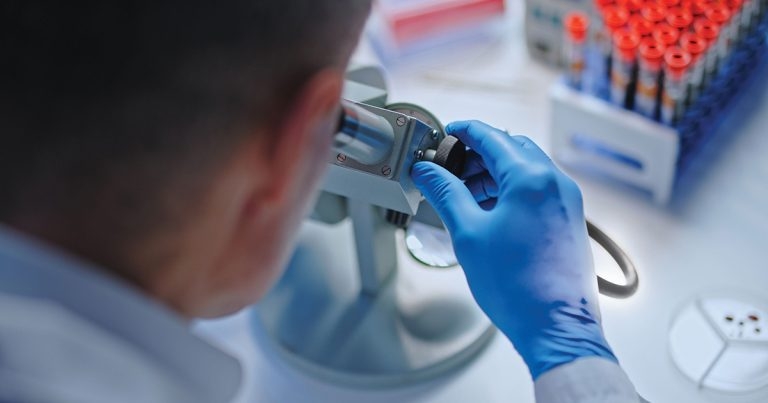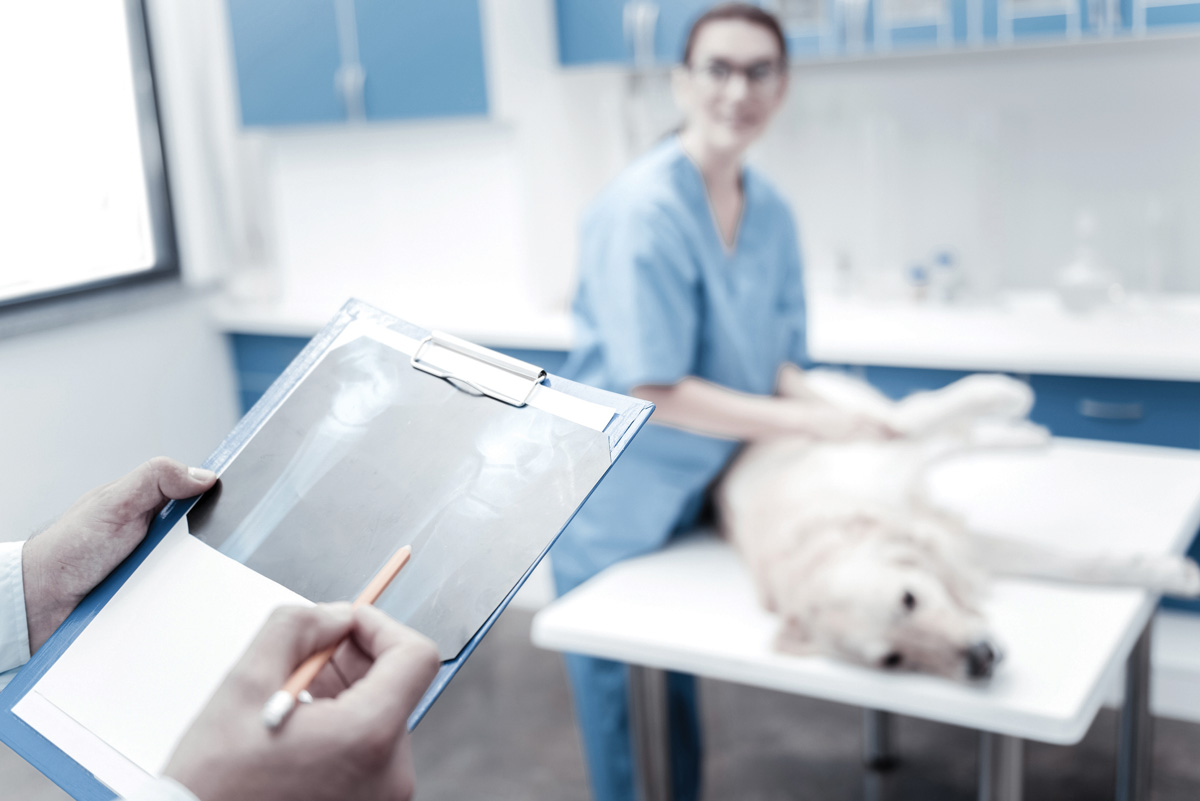1 Feb 2024
In the ever-evolving field of veterinary diagnostics, the traditional “this or that” approach to performing and assessing diagnostic tests in the clinic or at an external laboratory is changing. So, it is vital to ensure your practice is keeping up with the latest developments…

Image © iStock.com /Synthetic-Exposition
Depending on preference, a basic in-clinic set-up in recent years may typically include a haematology analyser, biochemistry analyser and a microscope. The requirement to send samples to external labs for specialist consultants to assess will always remain, but the advances in digital diagnostics could now be seen as a “blurring of the lines”.
While the digitisation of diagnoses occurred many decades ago, we now find ourselves amid a different kind of technological evolution – one that is, like much of the technology today, rapidly developing.
One could argue that, when comparing one analyser to the next, they are all much of a muchness. But what is now occurring is increased connectivity, the capability to seamlessly share information between devices and platforms – both in and out of the clinic – and the ability to share that information where necessary.
On the face of it, this doesn’t sound new because we’re accustomed to our devices communicating with each other; in fact, we’re even accustomed to them “talking” to us in one way or another. So, how does this impact the dynamics of the veterinary clinic?
The entire UK veterinary profession – from primary care practitioners and veterinary nurses to multidisciplinary specialists – is facing a decline in numbers.
What this means is many health care teams are being stretched; they are resource and time poor, all the while trying to do the best for patients and owners. Here presents a typical challenge: obtaining results from an external lab in a timely manner to reach the right diagnosis and decide the appropriate course of treatment.
If you have the ability to analyse your sample in-clinic, great, because logically the ability to test samples and assess results in-house will save the time it would take to send out a sample to an external lab and wait for the results. But a further assessment by a specialist clinical consultant may still be required in some cases – and this can be a tricky and time-consuming step – because broadly speaking they are not always as accessible as we’d like due to the aforementioned decline in numbers.
No matter the technology you’re working with, diagnostic test results will ultimately need to be examined by a human with the expertise to determine the clinical significance of the results, identify the differentials and formulate treatment plans while managing the concerns of pet owners.
The good news is contemporary (connected) solutions aim to address these issues by bringing the ability to do in-house testing, and by introducing that extra expert member into your clinic. The specialist areas covered have also become wide ranging and will likely cover the area required – pathology, cytology, dermatology, internal medicine, oncology and exotics, and across multiple disciplines.
If we dare to cast our minds back to the beginning of the pandemic, you may remember the first time you heard or considered the idea of an online meeting or a “virtual consultation”. This seemed absurd to many – how could we get anywhere by seeing each other on a screen? Could we confidently reach a diagnosis without physically seeing and assessing the animal?
We were suddenly in a situation where we were rapidly pushed to engage with virtual scenarios, and as it turns out, technology has its advantages. We have embraced virtual visits with our own doctors, therapists and nutritionists; we have even taken up virtual classes. It is clear that technology can help us be more time and cost-effective, removing unnecessary waiting times and enable better productivity.
The provision of a virtual environment in the context of veterinary diagnostics has, in more ways than one, transformed the ways we can approach diagnoses.
The pandemic inspired a great number of “virtual vet” business start-ups, and even before 2019 most practices would be working with a cloud-based veterinary practice management software program, where your devices, virtual machines, and servers are controlled by wireless technology and communicate over the internet. It helps veterinary health care teams organise the day-to-day tasks, store information and view diagnostic results.

It doesn’t matter what stage you are at in your career – whether you’re a graduate or a veterinary surgeon with more than 30 years’ experience – there will always be a time (sometimes on an overnight shift) where you’re the only surgeon present and you’d like to have a second set of eyes to help with a case. And there are solutions available today that meet that need without having the expert physically present in your clinic, and without having to send the sample physically out to an external laboratory and wait days for the result.
To clarify, we should accept that veterinary diagnostics has developed into a field that involves more than just hardware and software – it is now a combination of those physical in-house point-of-care instruments, the most advanced technologies and clinical expertise. Today, that can be through platforms that have an advanced AI capability integrated into the analyser, which allows for AI results to be delivered within minutes, or digital cytology interpreted by a clinical pathologist to be available within hours rather than five to seven working days.
Many vets are used to working with superficial learning AI in their practice, such as equipment that assesses x-rays, ultrasound scans, blood analysers and other diagnostic testing devices. This is otherwise known as machine learning, which depends on a predefined set of data represented by specific features.
While still incredibly valuable, recent innovations use deep learning AI, which automatically learns and identifies complex patterns and representations from raw data without the need for explicit feature engineering. So, in a situation where you’re looking to reach a diagnosis, this kind of deep learning can be exposed to tens of thousands of images of variations of cells, including bacteria, yeast, blood and crystals in the urine. This allows a comprehensive and accurate identification of the cells, and the possible causes, quickly.
While these are tremendous strides for the profession, a line exists between innovative veterinary diagnostic technology and devices created by tech-centric producers. Similar to any emerging field, inevitably visionary producers will exist, eager to seize new opportunities. However, veterinary medicine first and foremost prioritises the well-being and health of animals, emphasising the need to seek out established manufacturers with commitments to ethical practices, rigorous testing and a track record of maintaining the integrity of the field.
While AI is an intriguing addition to the portfolio of diagnostic solutions available to veterinary professionals, understandably some hesitation exists to adapt workflows to accommodate this new and less-understood technology, and rely on its capabilities. Is it really picking up this particular bacterium, or could it be something else?
Some manufacturers will now cater to this concern by providing an add-on service to (human) board-certified clinical pathologists who can be contacted 24 hours a day and 7 days a week or specialist clinical consultants who can be contacted 24 hours a day and 5 days a week via email, video or telephone call to give you the support you may need.
The advantages of this are not only to provide an extra layer of trust in the AI-driven results, but also for regular sample results where a second opinion would be beneficial to ascertain possible disease differentials as well as further necessary diagnostic testing or courses of treatment.
At Walsden Surgery, run by Hird and Partners in Yorkshire, the practice has implemented an analyser and online platform with this capability. As a case study, the surgery was able to diagnose an anal sac adenocarcinoma within just a few hours of a routine booking for a Labrador retriever to have its anal glands expressed.
Camilla Deamer, RVN at the surgery, said: “I can’t think of anything else that’s like it – especially in comparison to human health care where current pressures can mean long waiting times. When I tell clients I can get the results back either by tomorrow or even by the end of the day, they’re astonished.”
The dog was able to be referred to a hospital for surgery later that same week.
The impact of this collaborative approach is significant, promising a positive paradigm shift in the way veterinary diagnostics is approached and applied in the field.
The products and services on offer today mean you can access diagnostic results and more targeted specialist support a lot quicker than previously possible, enabling clinics to offer a broader range of services without relying on third-party facilities and ultimately contributing to the smooth operation of the clinic and timely diagnosis of patients – and, therefore, quicker treatment plans. As technology continues to progress, we can expect even more sophisticated and user-friendly diagnostic tools to become available, further enhancing the capabilities of in-house diagnostics to improve overall productivity.
Looking to the future, the veterinary community can anticipate a continued integration of cutting-edge technologies into in-house diagnostics. This will not only streamline the diagnostic process, but also contribute to the overall efficiency of veterinary care.
As we embrace these changes, it is crucial for veterinary professionals to stay informed and adapt to the evolving landscape by aligning with reputable providers, ensuring that patients receive the best possible care.